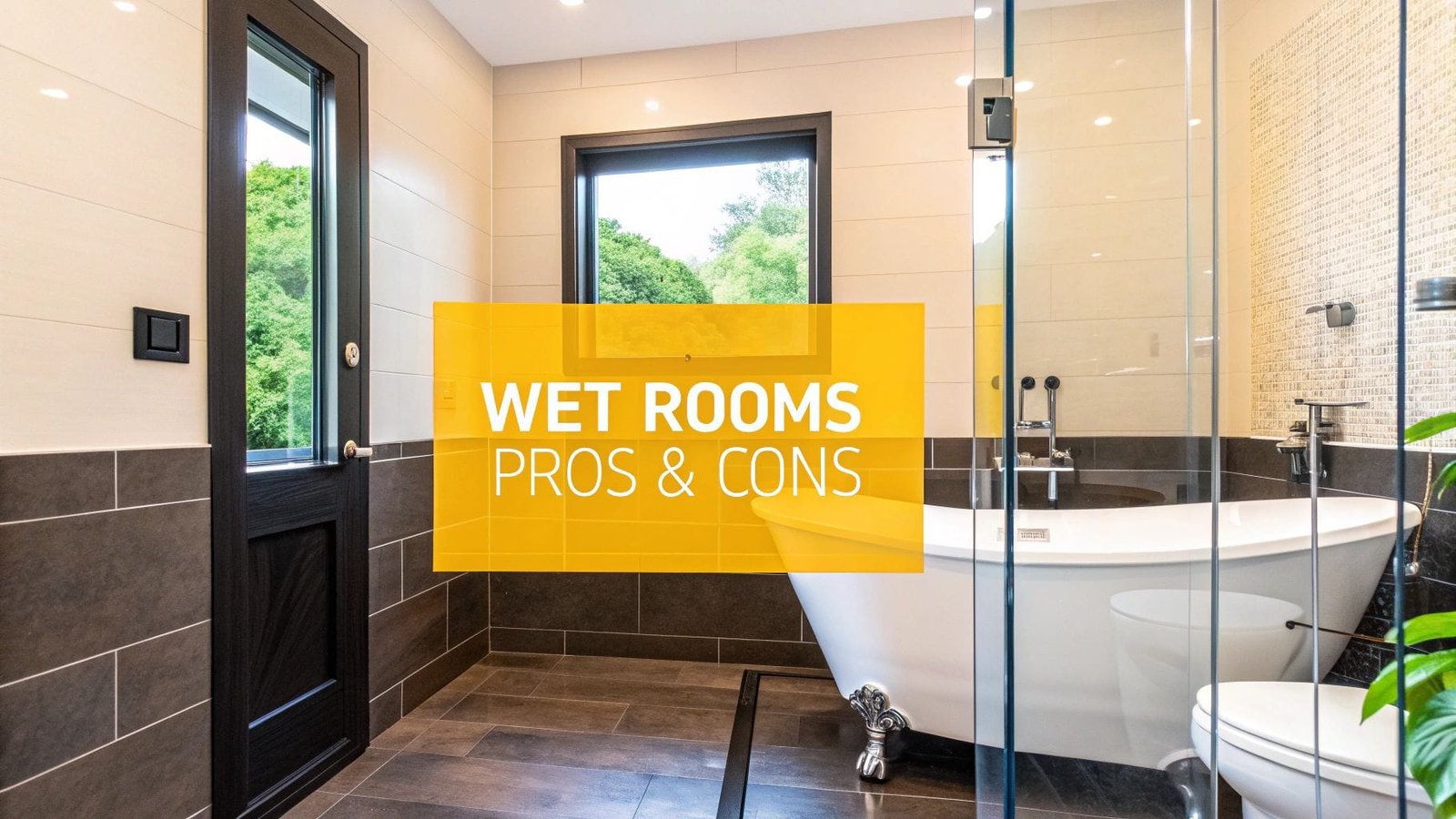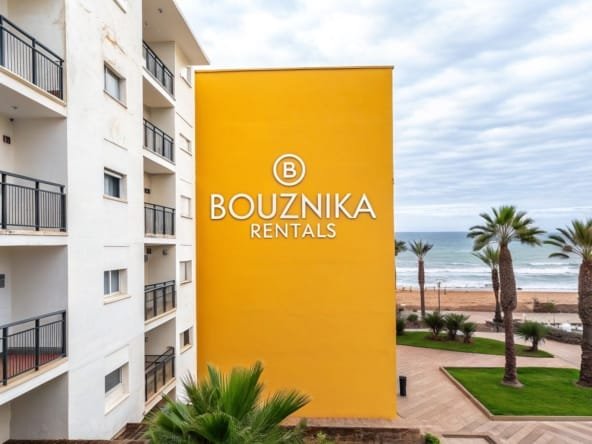When you get right down to it, the debate over wet rooms often comes down to a classic trade-off. On one hand, you get incredible accessibility and a sharp, modern look. On the other, you're looking at higher installation costs and the non-negotiable need for flawless, professional waterproofing. The right choice for you really depends on what you value more: forward-thinking design and accessibility, or a simpler, more budget-friendly installation.
Weighing the Pros and Cons of a Wet Room
A wet room is a fundamentally different concept from your standard bathroom. It's not just a shower without a curtain; it's a completely sealed, or 'tanked', room where the floor itself is the shower base. This design creates a seamless, level surface, which opens up a world of possibilities for both function and style. But as with any major design choice, those benefits come with their own set of challenges.
Before you make a final decision, it's crucial to grasp what separates this approach from a conventional bathroom. This isn't just a cosmetic choice—it affects everything from your daily routine and cleaning habits to the long-term resale value of your property. A wet room can feel like a luxurious, space-saving retreat, but it demands careful planning and a bigger upfront investment.
Wet Room vs Traditional Bathroom at a Glance
To simplify things, let's break down the core differences. This table offers a quick snapshot of how a wet room stacks up against a traditional bathroom layout across key features.
| Feature | Wet Room | Traditional Bathroom |
|---|---|---|
| Layout | Open-concept, barrier-free, level floor | Defined zones with separate shower/bath |
| Waterproofing | Entire room is 'tanked' (sealed) | Contained within the shower or bath area |
| Accessibility | Excellent for mobility issues | Limited by curbs, steps, and enclosures |
| Aesthetics | Minimalist, modern, and spacious feel | Can be traditional or modern, but more sectioned |
| Installation | Complex, requires specialist labour | Standardised, more DIY-friendly |
| Initial Cost | Higher due to labour and materials | Generally lower and more predictable |
As you can see, the two are worlds apart in their construction and philosophy. One prioritises openness and integration, while the other relies on established, compartmentalised design.
The decision to install a wet room is less about which is "better" and more about which is "right" for your specific circumstances. For a family needing a future-proof, accessible bathroom, the pros often outweigh the cons. For a budget-conscious renovator, the complexity and cost might be prohibitive.
Thinking about it this way is key. It's easy to get swept up in the appeal of a spa-like, open-plan bathroom. However, the practical side—installation, moisture control, and cost—needs just as much attention. Getting to grips with these fundamental pros and cons is the first real step toward making a smart choice for your home.
The Real Advantages of Installing a Wet Room
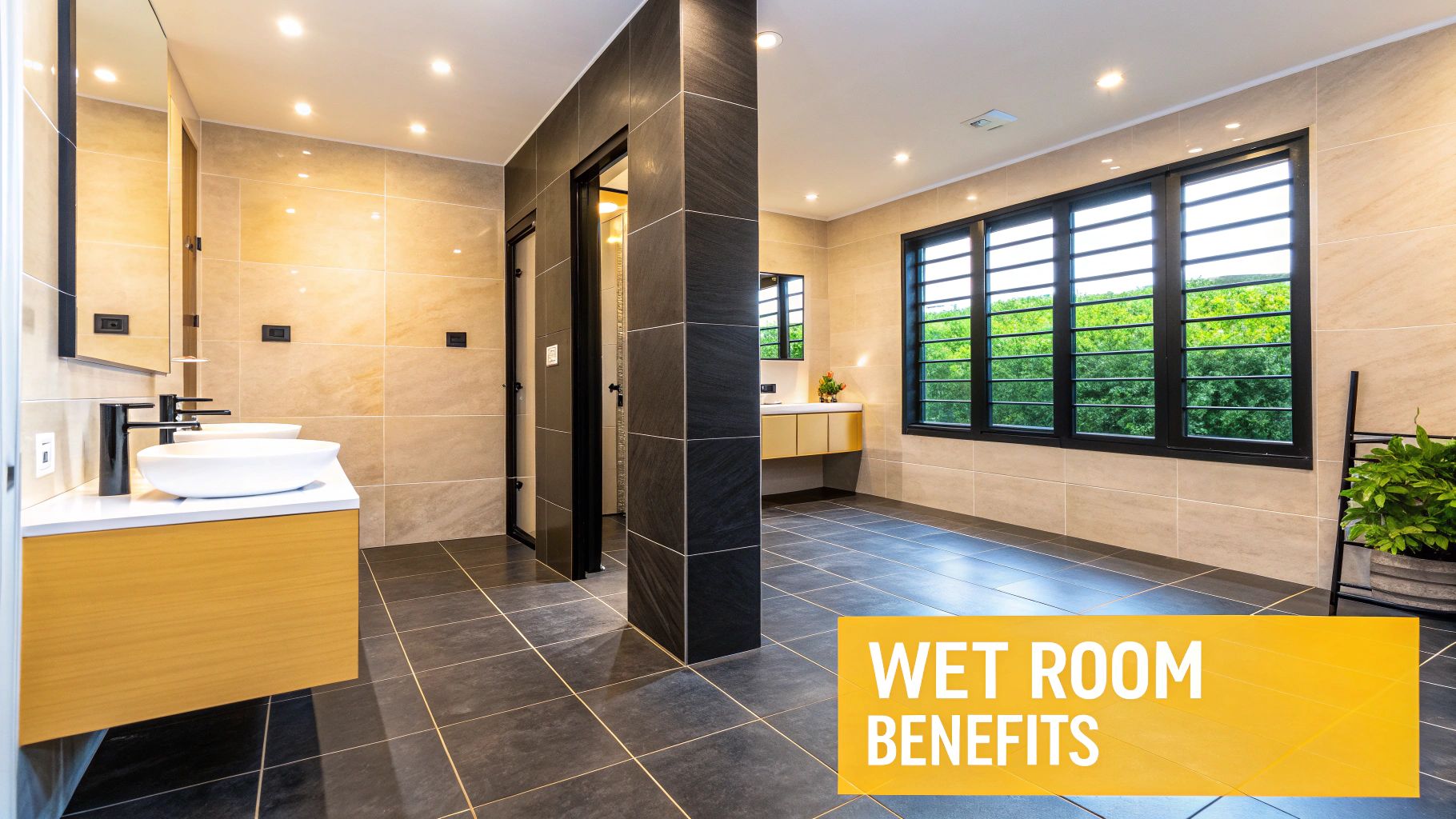
Sure, a wet room looks incredible, but its real genius is found in the smart, practical design that goes far beyond aesthetics. The benefits solve some of the most common household headaches, from future-proofing a home for years to come to making the most out of a tiny footprint. It’s a genuinely compelling choice for many homeowners.
Perhaps the single biggest plus is accessibility. When you remove the shower tray and get rid of any curbs or steps, you create a completely barrier-free space. This isn't just a nice-to-have feature; it's the very definition of universal design.
This level-entry layout makes day-to-day life safer and easier for everyone—from young children to older adults or anyone with mobility issues. It’s a forward-thinking design that supports multi-generational households and helps people age in place with dignity.
Creating an Illusion of Space
Wet rooms have an almost magical ability to make small bathrooms feel bigger. By taking out bulky shower enclosures and bathtubs, the room opens up, feeling instantly less cluttered and more expansive. This is a game-changer in compact city apartments or tight en-suites where every centimetre really does matter.
The seamless flow from the shower area to the rest of the floor creates long, unbroken sightlines, which tricks the eye into seeing more space than is actually there. It’s a minimalist approach that makes the entire room feel more breathable.
This space-saving quality is a huge reason for their popularity in dense urban centres. In Massachusetts cities like Boston, for example, a wet room can reclaim an average of 15-20% of floor space over a traditional bathroom. In high-value property markets, that kind of efficiency is why we’re seeing a 12% year-over-year increase in these installations. You can learn more about how modern designs are adapting to housing needs from the Massachusetts Housing Partnership.
The Luxury of Simplified Maintenance
Let’s talk about cleaning, or rather, the lack of it. With fewer corners, joints, and fiddly fixtures, there are simply fewer places for dirt and mould to hide. You can say goodbye to scrubbing grimy shower doors or trying to clean behind an awkward bathtub.
Because a wet room's surfaces are continuously waterproofed, cleaning is fast and incredibly efficient. The entire space is built to handle water, so you can often just wash down the whole floor with little fuss, keeping everything far more hygienic.
The real luxury of a wet room isn't just its spa-like appearance; it’s the profound simplification of daily life. Combining enhanced safety, a feeling of spaciousness, and easier cleaning transforms the bathroom from a purely functional room into a sophisticated and practical retreat.
It's this blend of practical advantages that turns a wet room from a passing trend into a genuinely smart home improvement. It delivers a better daily experience while adding real, long-term value to your property. By putting usability and clean aesthetics first, it ticks all the boxes for what makes a home both comfortable and desirable.
Understanding the Challenges and Drawbacks
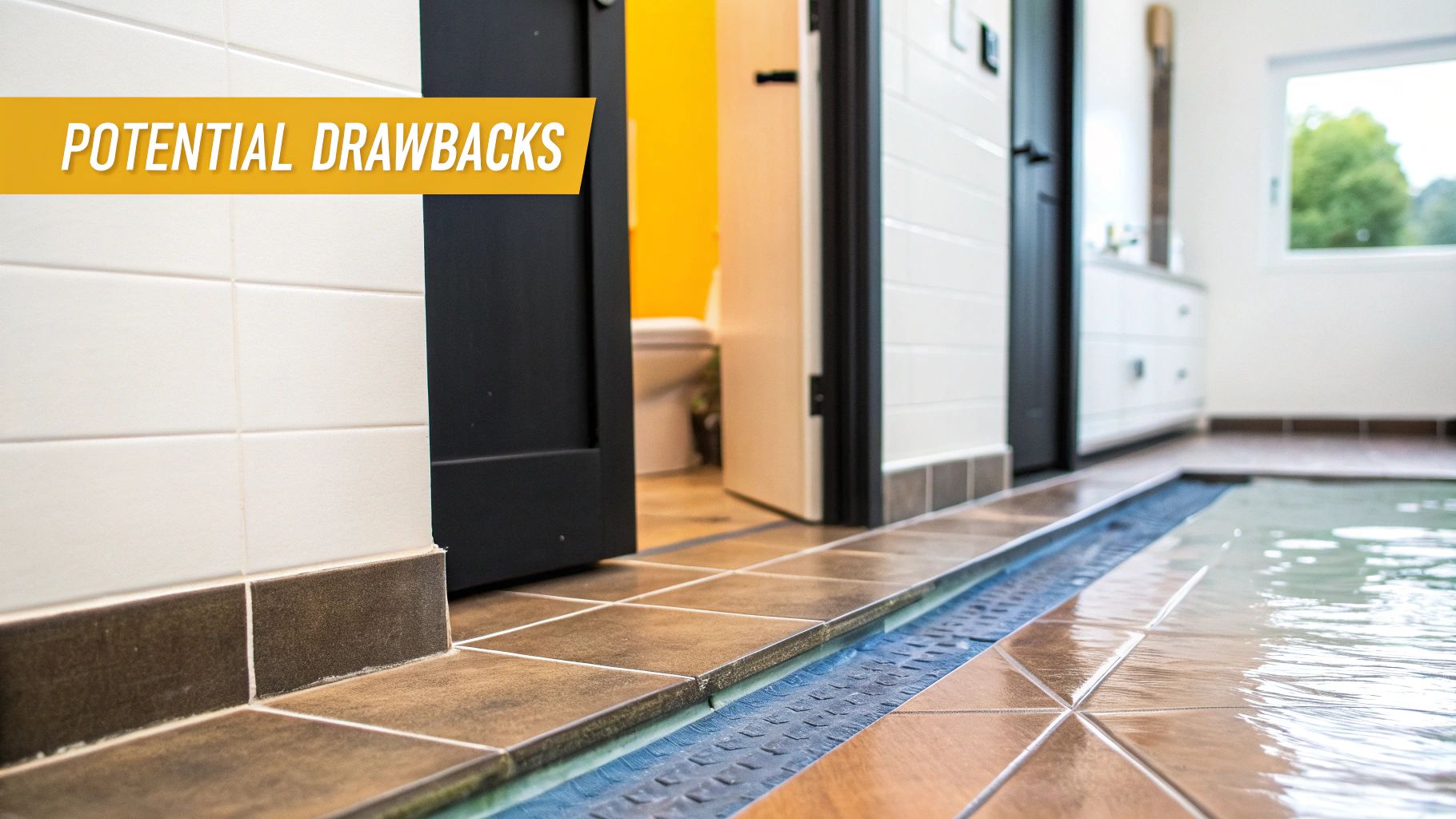
For all their stylistic appeal, it's vital to have a clear-eyed view of what a wet room demands. These aren't just minor quirks; they are serious considerations that call for meticulous planning, a bigger budget, and an unwavering commitment to getting the details perfect from the start. Cutting corners here can lead to some very expensive problems and daily annoyances down the road.
The single most critical element is the waterproofing, a process we in the trade call tanking. This goes far beyond just choosing waterproof tiles. It means creating a completely sealed, impermeable membrane that runs across the entire floor and extends up the walls, effectively forming a watertight 'tank' to contain every last drop of water.
Getting the tanking wrong is simply not an option. A shoddy job can result in slow, invisible leaks that silently wreak havoc on floor joists and seep into adjoining rooms, causing structural damage that takes years to reveal itself. This is precisely why you cannot compromise on hiring a certified professional. It's also the main reason the initial cost is significantly higher.
The Financial Reality of Wet Room Installation
Let's talk numbers, because the upfront investment is one of the first hurdles. A properly constructed wet room costs considerably more to install than a conventional bathroom, and the expenses run much deeper than the fixtures and tiles you see. You should brace for higher costs in a few key areas:
- Specialised Labour: You're not just paying for a plumber or a tiler. You are hiring a waterproofing specialist whose expertise is essential for the long-term integrity of the room. Their skill commands a premium, but it's the best insurance you can buy.
- Drainage Systems: Creating the perfect, subtle gradient in the floor so that water flows exactly where it needs to is an art. It requires not only skilled labour but also specialised drainage components built specifically for this purpose.
- Tanking Materials: The high-grade waterproof membranes, sealants, and bonding agents needed for a robust tanking system are a significant material cost you wouldn't have in a standard bathroom fit-out.
When you add it all up, the initial cost can be a real barrier for some. While a wet room often adds to a property's value, you must be financially prepared for that higher initial outlay.
The core commitment of a wet room is investing in what you cannot see. The success of the entire project rests on the flawless execution of the hidden waterproof layer, making expert labour the most crucial part of your budget.
Practical Day-to-Day Considerations
Living with a wet room also brings a few practicalities to the forefront that you need to think about early in the design stage. With no shower tray or full enclosure, water is going to splash. It's unavoidable. This means everything from your towels to the toilet roll is potentially in the line of fire.
Thoughtful design can certainly mitigate this—a simple glass panel or clever positioning of the vanity and toilet can make a world of difference. Still, it's a fundamental characteristic you have to plan for.
On top of that, the open-plan nature of a wet room creates a very humid space after a shower. Without powerful, efficient ventilation, that moisture will linger, potentially leading to issues with damp, mildew, and a generally clammy atmosphere. An extractor fan isn't just a nice-to-have here; it's a non-negotiable part of the system needed to protect your home's air quality and structural integrity.
Navigating Building Codes and Regulations
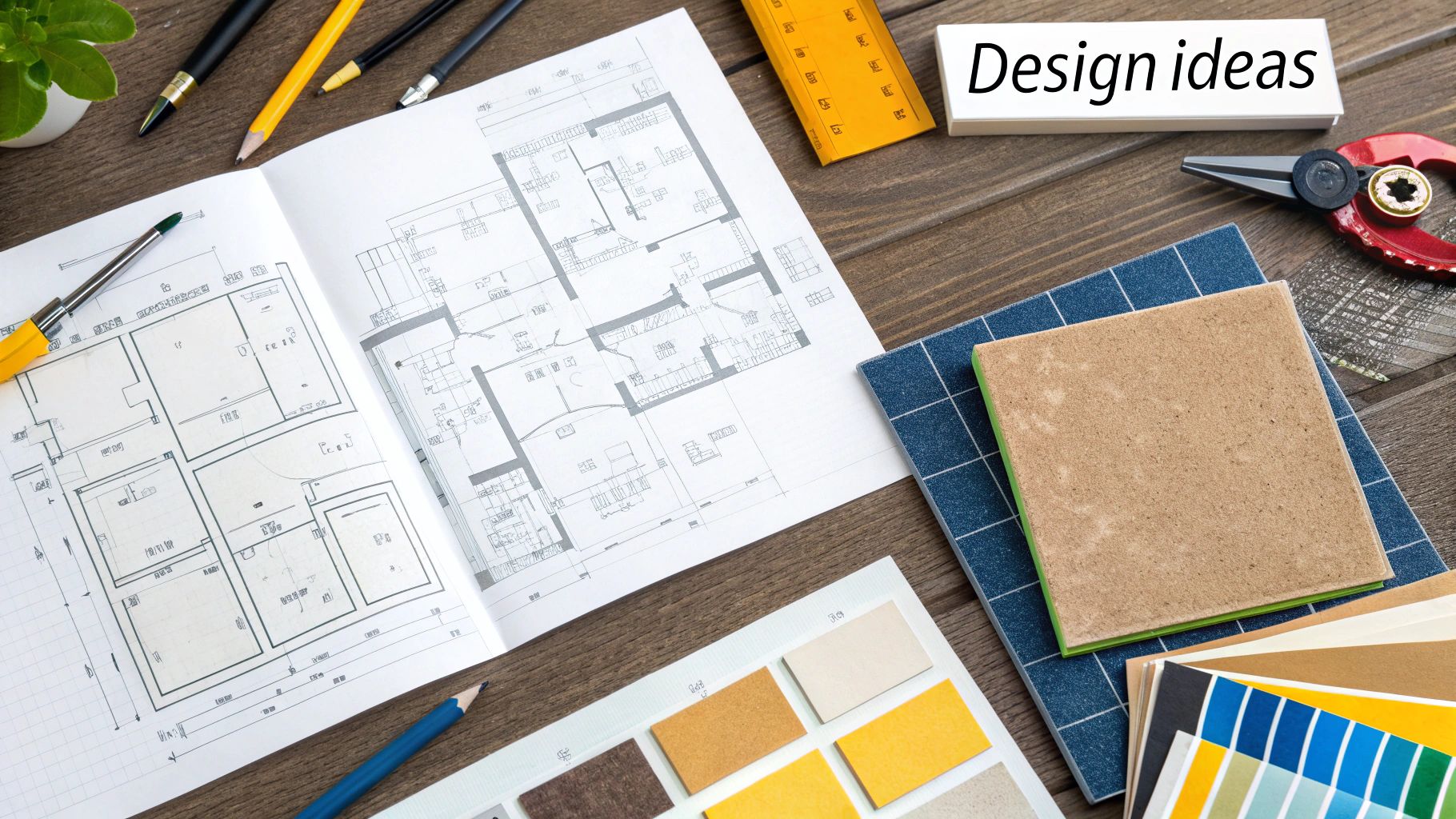
While the appeal of a wet room often comes down to its sleek look or practical accessibility, the project's real foundation is built on something far less exciting: regulatory compliance. Installing a wet room isn't just a style decision. It’s a full-scale construction project that has to meet strict local building codes and plumbing rules. Ignoring them is a surefire way to face expensive rework, failed inspections, and the nightmare of long-term water damage.
The heart of these regulations always boils down to three key areas: waterproofing, drainage, and ventilation. Codes will specify exactly how the waterproof 'tanking' membrane must be applied, making sure every centimetre of the floor and specific wall areas are completely sealed against moisture. This isn't a friendly suggestion; it’s a hard requirement to protect your home’s structural integrity.
Understanding Drainage and Ventilation Mandates
Proper drainage is just as critical in the eyes of inspectors. Regulations will dictate the minimum floor gradient—the slope—needed to channel every drop of water towards the drain without leaving puddles. This simple detail is crucial for preventing slip hazards and stopping mildew from taking hold. The rules will also cover the type and capacity of the drain itself, ensuring it can handle the water volume without backing up.
Ventilation is another area where codes get specific. An open-plan shower creates a lot of steam, so building regulations require powerful mechanical extractor fans to pull that moisture out of the air. The fan's required power, usually measured in cubic feet per minute (CFM), is often tied to the room’s overall size to guarantee proper air circulation and protect your home from damp.
Navigating these intricate rules is not a job for amateurs. You absolutely need to consult a professional contractor who knows the local codes inside and out. They are your best insurance against costly violations, ensuring your design is fully compliant from the plumbing hookups to the final waterproofing layer.
Wastewater Management and Local Health Rules
Beyond the primary building codes, you may also run into local health and wastewater regulations, which can introduce another level of complexity. This is particularly relevant for properties connected to private septic systems. In some regions, like Massachusetts, a wet room renovation can cost 10-15% more than a standard bathroom, mainly because of the specialised waterproofing and drainage systems required by state plumbing codes such as 248 CMR 10.10. These rules are in place to manage water flow and prevent overwhelming both municipal and private treatment systems.
This kind of oversight highlights just how essential a professional approach is. Although the Moroccan real estate market has its own set of regulations, the core principle is identical: knowing the local rules is paramount. Our guide on property investment in Casablanca discusses the importance of this due diligence. Ultimately, the regulatory landscape—whether in Casablanca or abroad—will shape the complexity and cost of your project, making expert guidance a necessity.
Cost Breakdown: Wet Room vs. Traditional Bathroom
Let's get straight to the point: the financial side of things is often what tips the scales when deciding between a wet room and a conventional bathroom. While a wet room brings that stunning, minimalist look and fantastic accessibility, it’s important to know that these advantages usually come with a higher price tag. The initial outlay for a wet room is almost always more than for a standard bathroom renovation.
So, where does that extra money go? The biggest chunk of the budget is swallowed by the specialist labour and materials needed for comprehensive waterproofing. In a typical bathroom, water is kept in check by a shower tray or a bathtub. A wet room, however, requires the entire floor and lower walls to be turned into a single, seamless, waterproof shell—a process we call "tanking". This involves meticulous work: applying a waterproof membrane, creating a very slight, almost imperceptible, slope in the floor towards a specialised drain, and sealing everything perfectly. It’s a job for a true craftsman.

Deconstructing The Expenses
When you start looking at the line items, the cost difference becomes crystal clear. The labour for a wet room is far more intensive and demands a certified waterproofer, who naturally charges more than a general plumber or tiler. The materials bill also climbs higher because you're paying for high-performance tanking kits, industrial-grade sealants, and often, more expensive non-slip tiles, which are essential for safety.
The image above really drives this home. While the upfront investment for a wet room is noticeably steeper, both renovations can add a similar percentage to your property's value. This shifts the decision from a purely financial one to one that’s more about your lifestyle and personal taste.
A Comparative Cost Table
To put some real numbers to this, here’s a look at how the costs typically break down for a mid-range renovation project. It clearly shows where the budget for a wet room starts to pull away from a standard bathroom setup.
Estimated Cost Comparison: Wet Room vs. Traditional Bathroom
| Cost Component | Wet Room (Estimated Cost) | Traditional Bathroom (Estimated Cost) |
|---|---|---|
| Waterproofing/Tanking | £1,000 – £1,500 | £200 – £400 |
| Labour (Specialist Tiling & Plumbing) | £2,500 – £4,000 | £1,500 – £2,500 |
| Drainage System | £300 – £600 | £50 – £150 (for tray) |
| Tiles (Non-Slip) | £800 – £1,200 | £500 – £800 |
| Fixtures & Fittings | £1,500 – £3,000 | £1,500 – £3,000 |
| Total Estimated Cost | £6,100 – £10,300 | £3,750 – £6,850 |
As you can see, the core difference lies in the foundational work—the waterproofing and specialised labour. This isn't the place to cut corners.
The extra cost of a wet room is really an investment in the long-term structural integrity of your home. Trying to save money on waterproofing or by hiring someone without proven experience is a classic false economy that can lead to disastrous and expensive water damage down the line.
This financial reality is a critical consideration for property owners and investors everywhere. Understanding these renovation costs is vital, especially in dynamic markets. For a closer look at how these factors play out, our analysis of real estate in Casablanca offers some valuable insights into making smart investment decisions.
Making the Right Choice for Your Home
So, after weighing all the pros and cons, how do you decide? The truth is, there's no single "best" answer. The right choice is the one that fits your specific property, your lifestyle, and your budget. It all boils down to what you value most.
A wet room can be a game-changer for certain situations. Think about a family planning for their future, or someone needing to accommodate an elderly parent. In these cases, the barrier-free design isn't just a stylish feature; it’s a genuine improvement to their quality of life. The same goes for anyone with a small city apartment. A wet room can magically open up a tight space, turning a cramped bathroom into something that feels airy and modern.
But it’s just as important to know when a wet room simply isn’t the practical choice. If you're working with a tight renovation budget or you're a keen DIY-er, the high cost of professional waterproofing and specialised labour can be a real deal-breaker. Similarly, if your home has known structural quirks or a particularly fussy plumbing system, the complexity and potential risks can easily overshadow the sleek aesthetic.
A wet room shines when its core benefits—unbeatable accessibility and a sense of space—solve a real problem for the homeowner. It becomes a poor investment when practicalities like budget or structural limitations are pushed aside for looks alone.
Ultimately, this needs to be a well-considered decision. You have to balance the steeper upfront cost and the necessity of hiring specialists against the day-to-day convenience and the unique appeal it adds to your property. For anyone exploring the property market here, getting these details right is crucial. You can dive deeper into making smart real estate choices with our Marrakech Real Estate Guide. This will give you the confidence to pick the design that truly works for your home and your long-term plans.
Of course. Here is the rewritten section, crafted to sound like it was written by an experienced human expert.
Common Questions About Wet Rooms
When you start thinking about a wet room, a few practical questions always come up. Let's tackle some of the most common ones I hear from clients, so you can get a real sense of what it’s like to live with one and properly weigh the pros and cons.
How Do You Stop Towels and Toilet Paper from Getting Soaked?
This is probably the number one concern, and understandably so. The answer really comes down to smart, practical design.
You don't have to sacrifice an open feel for a dry toilet roll. A well-placed glass panel can shield the rest of the room from the worst of the spray without boxing the shower in. It's also about strategic placement – simply keeping your towel rail and toilet well away from the direct shower zone makes a huge difference. Most successful designs incorporate covered toilet roll holders and heated towel rails just outside the immediate splash area.
Isn't a Wet Room Always Cold?
It’s true that a large, tiled space can feel a bit cooler than a cosy, traditional bathroom. But this is easily solved, and the solution actually adds a touch of luxury.
Underfloor heating is the go-to choice for wet rooms, and for good reason. It not only keeps the room feeling comfortably warm underfoot but also helps the floor dry out much faster after you’ve showered. It turns a potential negative into a real positive.
People often worry that wet room floors are a slipping hazard. The truth is, a properly installed wet room must use specific non-slip tiles. These have a much higher grip rating than standard bathroom tiles, making them genuinely safer when wet.
What’s the Maintenance Really Like?
Honestly, maintenance is often easier than with a standard bathroom. Because you've eliminated the typical shower tray and enclosure, there are far fewer awkward corners and crevices for grime to build up in.
A quick squeegee of the glass and floor after showering is all it takes to prevent water spots and soap scum. The most important task is keeping the drain clear and periodically checking the silicone seals around fixtures to make sure everything stays perfectly watertight.
At Rich Lion Properties, we know that details like these make all the difference when buying or selling a home in Morocco. Whether you’re drawn to a sleek wet room or a classic bathroom, our team has the local expertise to guide you. See how we can help you make the right choice for your property by visiting us at https://richlionproperties.com.
